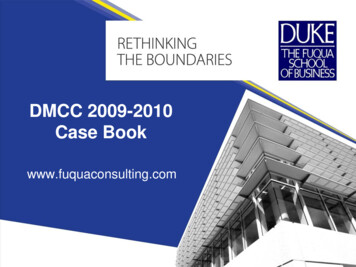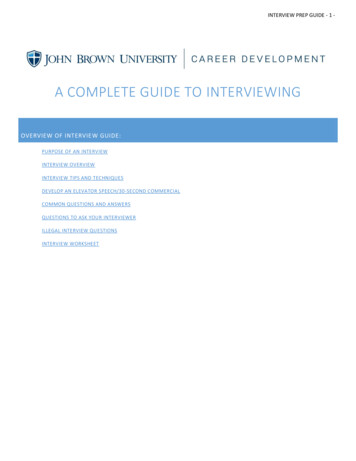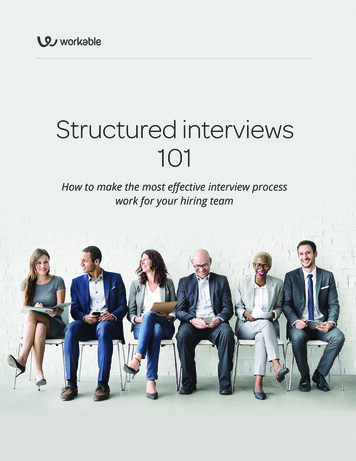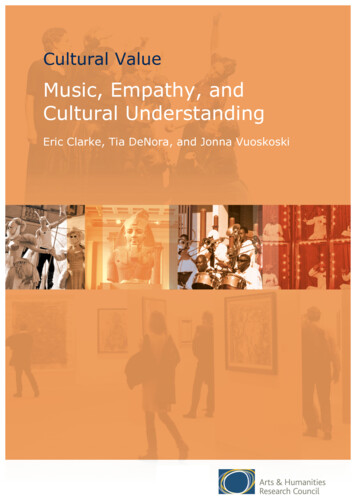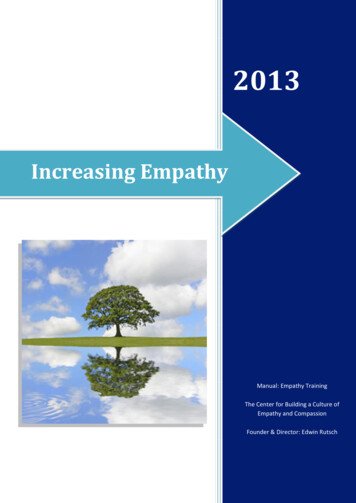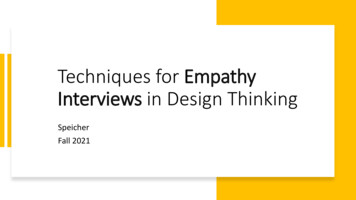
Transcription
Techniques for EmpathyInterviews in Design ThinkingSpeicherFall 2021
Your Own ExperienceImagine visiting your DoctorLet’s say you are feeling ill, so you take a day off and go to a doctor’s appointment. In order to give the correct diagnosisto your problem, the doctor conducts an interview -- You are now the user being interviewed.Now imagine you are explaining your problem to the doctor, whose attention is fully focused on texting on his cellphone,but tells you: “keep talking, I’m listening, I can hear you”.The doctor is not present and is distracted. He is listening without hearing and could end up giving you the wrongdiagnosis. So, you leave angry, frustrated, dissatisfied What do the actions of that doctor tell you?Are you really important to that doctor?Does your life even matter to the doctor?Can you trust them?Do you feel heard? Where is the empathy?
The Importance of Empathy Interviews They allow users to speak about what is important to them. They focus on the emotional and subconscious aspects of the user. They allow interviewers to gain insights on how users behave in given environments and situations. They can reveal solutions you might not have discovered otherwise, or unmet needs & challenges youmight be overlooking. They go deeper, beyond your run of the mill questions. They’re about making the subject feel at ease so he or she can be open and honest. They offer interviewers a chance to observe body language and reactions of the subjects. This allows forspontaneous questions based on observations.
How to Select SubjectsHere are four questions to ask yourself beforeselecting subjects for empathy interviews. How many people do I need to interview? Who do I recruit? How do I know who the target customer is? How do I recruit the people to interview?
How do You Conduct an Empathy Interview?ImmerseObserveexperience what usersexperienceview users and theirbehaviors in the contextsof their livesEngageinteract with and interviewusers through schedulesand “intercept” encounters
What Constitutes a Bad Interview Question?It’s important to ask questions that allow the interviewee/users to give long answers. Never push your thoughts onthe interviewee. Be mindful that open-ended questions can be good, but sometimes they can be too broad.Here is an example where you can only expect a Yes or No answer:Interviewer: Do you like swimming?User: NoInterviewer: How about tennis?User: NoInterviewer: I play tennis. You should try it. Have you ever thought about trying tennis?User: No
What Constitutes a Good Interview Question?Ask questions that trigger delightful emotionFor example:Tell me about delightful moments you experienced when you went biking?Ask “show me” questions, like:Show me how you use your scheduling app?
Create a Comfortable AtmosphereAs an interviewer you want a place that is familiar andcomfortable to the user. Where the user is surrounded byobjects that represent them. This will make them feel relaxedand allow them to open up.It could be a place where they spend most of their time, like intheir house or office. If you see something in the space thatintrigues you, ask the user to explain the story of that item.
An Example Method of Empathy InterviewingIntroduce yourself.Introduce your project.Shift your focus to the interviewee (ask name, where they come from).Build rapport.Ask about specific instances or occurrences (“Tell me about the last time.”)Keep questions to fewer than ten words.Ask one question at a time.Encourage stories.Look for inconsistencies and contradictions; what people say and do can be very different.Observe non-verbal cues (hand gestures, facial expressions)
Don’t suggest answers to your questions.Ask neutral questions like “What do you think about.?”Explore emotions like “Why do you feel.?” “What do you feel about.?”Question statements:If you get stuck, ask “why?” Constantly asking “why” digs deeper into emotion and motivation which helpsyou understand user behavior and identify needs.“Why?”“Why did you do/say/think that?”“Really? And why was that?”“Can you say more about that?”“Tell me more.”“And what were you feeling then?”Lastly, thank them and wrap things up.
Always have a beginner’s mindsetSuspend your judgments. You’re not there to judge, so keep an open mind – this mindset isrequiredBe fully present. Someone can tell if you’d rather be elsewhere.Show each interviewee that they are the most interesting, person you have ever met.Silence all devices. Do not look at your texts or answer phone calls!Things toRememberAlways bring a voice recorder to document the interview.Interview in pairs. One can ask questions whilst the other takes notes or take turns.Use a permission form for taking photographs.Use release documents for interviewee to sign.Also, explain how the person’s data and any data you collect will be used from theinterview.Leave 30 minutes or so between each interview. This gives the interviewer some time totake additional notes and compile their thoughts while everything is still fresh in their mind.
Empathy interviews are about having authenticconversation with the interviewee.ConclusionThey allow you to understand emotions,motivation and choices the user makes. Therefore,you to become familiar with their needs and designto satisfy them.It’s important to go out and meet your intervieweein an environment that is familiar to them.Observe, engage, immerse!
Ask the 5 Why’s!Always ask “why?”Even when you think you know theanswer, you maybe surprised by acompletely different answer that revealsaspects you may not have considered.This could lead you to solutions you didnot anticipate
Interviews in Design Thinking Speicher Fall 2021. Your Own Experience Imagine visiting your Doctor Let’s say you are feeling ill, so you take a day off and go to a doctor’s appointment. In order to give the correct diagnosis . Does your life even matter to the doctor? Can





